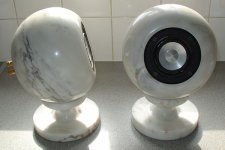Set up in the system
Hi all,
I've had a good listen. In fact I've spent almost every spare minute spinning vinyl.
Unfortunately I don't have a particularly large listening area, in fact it is quite small. This means that the speakers have to be quite close to the front wall. The right hand speaker is also quite close to side wall. Luckily there is a large fireplace that gives a bit more air on that side.
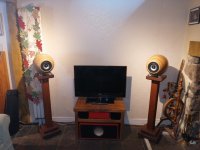
You can see from the size of my TV where my main interest lies.
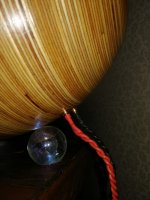
The termination of the speaker cables is good and neat and are barely visible from the room. Making everything visibly tidier makes for greater WAF. Greater WAF results in greater flexibility of positioning which results in better sound quality. In my system making things prettier actually makes them sound better.
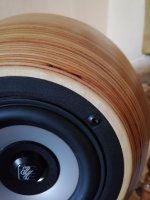
The rebate for the driver came out absolutely perfectly sized, the driver is totally flush with no gaps. The black stainless button heads just disappear.
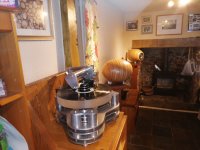
The colour and finish of the speakers and the stands fit right in with the decor of the room, wood and exposed stone.
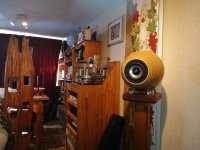
One advantage of living in a 17th century cottage is thick stone walls. I never heard my neighbours, who are absolutely lovely, and more importantly they never hear me. The last thing I want is to be a nuisance neighbour.
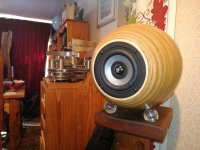
My design goals were to make a speaker that not only sounds great but also looks great. I think that I have achieved the second part. Next up the more important first part.
Niffy
Hi all,
I've had a good listen. In fact I've spent almost every spare minute spinning vinyl.
Unfortunately I don't have a particularly large listening area, in fact it is quite small. This means that the speakers have to be quite close to the front wall. The right hand speaker is also quite close to side wall. Luckily there is a large fireplace that gives a bit more air on that side.

You can see from the size of my TV where my main interest lies.

The termination of the speaker cables is good and neat and are barely visible from the room. Making everything visibly tidier makes for greater WAF. Greater WAF results in greater flexibility of positioning which results in better sound quality. In my system making things prettier actually makes them sound better.

The rebate for the driver came out absolutely perfectly sized, the driver is totally flush with no gaps. The black stainless button heads just disappear.

The colour and finish of the speakers and the stands fit right in with the decor of the room, wood and exposed stone.

One advantage of living in a 17th century cottage is thick stone walls. I never heard my neighbours, who are absolutely lovely, and more importantly they never hear me. The last thing I want is to be a nuisance neighbour.

My design goals were to make a speaker that not only sounds great but also looks great. I think that I have achieved the second part. Next up the more important first part.
Niffy
Sound quality
Hi all,
I had come into this project with high expectations. I am very familiar with the Jordan jx92 driver. Probably the best system that I have ever heard used a short line of 4 jx92s per channel. The rest of this system is about 10 times the cost of mine so if I can get in the same ball park I'll be happy. The majority of people who have experience of both jx92 and eikona prefer the eikona so hopefully I'm off to a good start.
Being a Jordan driver I had expected midrange magic and these speakers do not disappoint. They have a richness and smoothness but also have a real sense of solidity. Often when you find a speaker with warmth and richness in the midrange it can sound a bit airy and diaphanous. Although these speakers have a real sense of space and air around each image each image is solid. I don't just mean solidly located but also that the sound is emanating from something solid. Vocals don't hang in space, they stand in space. The quality of the midrange is probably largely down to not having a crossover mucking everything up.
I had been a bit worried that the quality of the top end might be lacking compared to using a dedicated tweeter and that any cone breakup might add a bit of harshness in the sibilance region. The top end of the eikona is beautifully extended and smooth. No need to worry at all. Many people who use the jx92s add a supertweeter to fill out the top end. With the eikona this is not at all necessary. I think that the improvement in the top end is one of the biggest differences between the two drivers.
When I initially set up the speakers I ran them without the subwoofer. Even in a sealed cabinet they go surprisingly low. More importantly as they give up at lower frequencies they do so with real decorum. They don't complain or try to force out notes that are beyond them, they just bow out gracefully. My previous speakers gave up with much more complaint, the distortion of the bottom end colouring the midrange. The addition of a high pass filter helped cure this.
They sound like the -3dB point is lower than the calculated 86hz. It probably isn't but because of the way they roll off it sounds like it. More important than bass depth is bass articulation. You get a real sense of the character of bass notes. I have heard it said that to improve your bass upgrade your tweeter. This is because the character of bass instruments is carried in their harmonics at higher frequencies. If you stick a crossover into the mix much of the harmonics will not be in phase with the fundamental. The parts of the sound don't line up anymore and the character is lost.
When I first added the sub I just couldn't get it to integrate at all. Then I remembered that my previous speakers had a second order filter on the bottom end. This meant that they were out of phase at the crossover. To fix this I reversed the polarity of the subs driver. Flipping the polarity back solved the problem and seamless integration was achieved.
I had been holding the idea of adding an active filter in reserve. This would have been used if the bottom end gave up with any signs of distress. As the roll off has no issues one is not required here. Likewise there is no audible breakup in the sibilance region so no notch filters or similar are required either. The final possible filter would be for baffle step. Possibly due to the shape of the cabinet baffle step doesn't seem to be a problem. The bottom end sounds perfectly in balance with the midrange. With these speakers absolutely no additional filtering is required. Not only does this avoid putting any thing in the signal path that could mess with the phase coherence of the speakers it also saves on the cost of building said filter system. I think my decision to forgo a measurement microphone has been vindicated.
The one area of sound quality that keeps surprising me is what I refer to as mid-bass. This is the bit between the upper-bass and lower-midrange, in the range 200-500hz. It is so clean and tight. Wooden bodied instruments and toms have real character. This could be due to the driver being so much lighter than one that would normally be used for this frequency range.
To prevent this post from getting to long and because I've got to go to work I'll sign off now.
Niffy
Hi all,
I had come into this project with high expectations. I am very familiar with the Jordan jx92 driver. Probably the best system that I have ever heard used a short line of 4 jx92s per channel. The rest of this system is about 10 times the cost of mine so if I can get in the same ball park I'll be happy. The majority of people who have experience of both jx92 and eikona prefer the eikona so hopefully I'm off to a good start.
Being a Jordan driver I had expected midrange magic and these speakers do not disappoint. They have a richness and smoothness but also have a real sense of solidity. Often when you find a speaker with warmth and richness in the midrange it can sound a bit airy and diaphanous. Although these speakers have a real sense of space and air around each image each image is solid. I don't just mean solidly located but also that the sound is emanating from something solid. Vocals don't hang in space, they stand in space. The quality of the midrange is probably largely down to not having a crossover mucking everything up.
I had been a bit worried that the quality of the top end might be lacking compared to using a dedicated tweeter and that any cone breakup might add a bit of harshness in the sibilance region. The top end of the eikona is beautifully extended and smooth. No need to worry at all. Many people who use the jx92s add a supertweeter to fill out the top end. With the eikona this is not at all necessary. I think that the improvement in the top end is one of the biggest differences between the two drivers.
When I initially set up the speakers I ran them without the subwoofer. Even in a sealed cabinet they go surprisingly low. More importantly as they give up at lower frequencies they do so with real decorum. They don't complain or try to force out notes that are beyond them, they just bow out gracefully. My previous speakers gave up with much more complaint, the distortion of the bottom end colouring the midrange. The addition of a high pass filter helped cure this.
They sound like the -3dB point is lower than the calculated 86hz. It probably isn't but because of the way they roll off it sounds like it. More important than bass depth is bass articulation. You get a real sense of the character of bass notes. I have heard it said that to improve your bass upgrade your tweeter. This is because the character of bass instruments is carried in their harmonics at higher frequencies. If you stick a crossover into the mix much of the harmonics will not be in phase with the fundamental. The parts of the sound don't line up anymore and the character is lost.
When I first added the sub I just couldn't get it to integrate at all. Then I remembered that my previous speakers had a second order filter on the bottom end. This meant that they were out of phase at the crossover. To fix this I reversed the polarity of the subs driver. Flipping the polarity back solved the problem and seamless integration was achieved.
I had been holding the idea of adding an active filter in reserve. This would have been used if the bottom end gave up with any signs of distress. As the roll off has no issues one is not required here. Likewise there is no audible breakup in the sibilance region so no notch filters or similar are required either. The final possible filter would be for baffle step. Possibly due to the shape of the cabinet baffle step doesn't seem to be a problem. The bottom end sounds perfectly in balance with the midrange. With these speakers absolutely no additional filtering is required. Not only does this avoid putting any thing in the signal path that could mess with the phase coherence of the speakers it also saves on the cost of building said filter system. I think my decision to forgo a measurement microphone has been vindicated.
The one area of sound quality that keeps surprising me is what I refer to as mid-bass. This is the bit between the upper-bass and lower-midrange, in the range 200-500hz. It is so clean and tight. Wooden bodied instruments and toms have real character. This could be due to the driver being so much lighter than one that would normally be used for this frequency range.
To prevent this post from getting to long and because I've got to go to work I'll sign off now.
Niffy
Nice work, Niffy!
Enjoy the fruits of your labour 🙂.
Thanks Colin,
Coming from you that's a real compliment. Although our designs are quite different I took great inspiration from your project.
Niffy
It's a very good thing that that turntable is so very good looking.
You had a high bar.
Thanks mhenschel,
The turntable gets people who have no interest in audio talking. So far the speakers are having the same effect.
Niffy
On the other hand you could spark talk about linear tracking and effective arm length too.
I think linear tracking arms and full range driver systems like yours are of a kind.
If I'd stopped to think about it, I'd have guessed that you had a Kuzma or a Conductor... perhaps after retiring your old Eminent Technology...
I think linear tracking arms and full range driver systems like yours are of a kind.
If I'd stopped to think about it, I'd have guessed that you had a Kuzma or a Conductor... perhaps after retiring your old Eminent Technology...
The concept of having a very short armtube and a full range driver are very similar. A long armtube will have its bending mode resonant frequency somewhere in the midrange. The way the arm controls the cartridge above and below this frequency are quite different. The control below resonance being much better, most of the colouration being due to modes above resonance. By pushing the resonant frequency above the audio band the arm now acts as a single full range entity.
Niffy
Niffy
Love the look of the turntable. I build TT's too but nothing as flash or complex as yours. I assume you built it? Are you a machinist? Your attention to detail indicates that. Not that others can't think in that way, but it does come naturally.
Thanks Impunity,
I did indeed build it. I'm am not a machinist but I do have a degree in composite engineering which definitely helped at the design stage. When I built the turntable I didn't have the luxury of a workshop. The entire thing was built on a black and decker workmate (set up in the corner of the kitchen) with basic tools, no lathes or milling machines.
Although I now have a space to use as a workshop I still only have a basic tool kit, pillar drill, a couple of routers, angle grinder and a selection of hand tools. Part of the fun of designing and building anything for me is working out how to do it with the tools I have available. If I need a tool I don't have I will either make it myself (like the turntable used to rotate the speakers) or buy it.
Niffy
I did indeed build it. I'm am not a machinist but I do have a degree in composite engineering which definitely helped at the design stage. When I built the turntable I didn't have the luxury of a workshop. The entire thing was built on a black and decker workmate (set up in the corner of the kitchen) with basic tools, no lathes or milling machines.
Although I now have a space to use as a workshop I still only have a basic tool kit, pillar drill, a couple of routers, angle grinder and a selection of hand tools. Part of the fun of designing and building anything for me is working out how to do it with the tools I have available. If I need a tool I don't have I will either make it myself (like the turntable used to rotate the speakers) or buy it.
Niffy
Michell argo hr upgraded to vibe (TEAD) Specification by Tom Evans for preamp with Hypex based class D power amps. I have a Graham Slee Reflex M phono stage (modded) and ortofon 2M black cartridge.
I have just come into the possession of a michell ISO hr phonostage and have been loaned a denon dl304. The denon cartridge seems to really like these speakers.
I have just come into the possession of a michell ISO hr phonostage and have been loaned a denon dl304. The denon cartridge seems to really like these speakers.
Having been an avid reader of The Audio Amateur et al and in particular the Jung-Didden-Galo regulators and Richard Marsh designs (but less a builder... I plead inoperable workaholicism) I was immediately attracted to Tom Evans' products and their Lithos regulation (so much like the Super Reg) I'm interested in your take on the TEAD stuff. (Aside from you liked it enough to buy some).
The Groove didn't tempt you?
The Groove didn't tempt you?
They sound like the -3dB point is lower than the calculated 86hz.
Toole has shown that F3 is a meaningless data point for human. Our perception makes F6, F10 much more useful in terms of what you hear as far as bass extention goes.
dave
Reminds me of Susan Parker's work: Susan's Spheroidal Marble Loudspeakerslooks like fujitsu td712z
Attachments
Having been an avid reader of The Audio Amateur et al and in particular the Jung-Didden-Galo regulators and Richard Marsh designs (but less a builder... I plead inoperable workaholicism) I was immediately attracted to Tom Evans' products and their Lithos regulation (so much like the Super Reg) I'm interested in your take on the TEAD stuff. (Aside from you liked it enough to buy some).
The Groove didn't tempt you?
Probably the best system that I've heard, the one with the 4 x jx92 arrays, uses all TEAD gear. I got the vibed argo for a ridiculously good price. I might well get the ISO HR upgraded with the lithos regulators as well. Alternatively I might tweek it myself using something like sparkoslabs regulators, almost as good as lithos but a lot cheaper. It's a bit more DIY that way. Sound quality wise TEAD kit is amongst the best.
Toole has shown that F3 is a meaningless data point for human. Our perception makes F6, F10 much more useful in terms of what you hear as far as bass extention goes.
dave
True.
@Effy
There are also these
NewClassD MK11 UWB-2 Regulators
I have a pair (+/-) to (possibly) retrofit an old preamp.
But for my new builds I'm going to use Jan Didden's Super Regulator. I just got the boards a little while ago (finally).
Super Regulator – diyAudio Store
And the purchase helped support diyaudio!!
There are also these
NewClassD MK11 UWB-2 Regulators
I have a pair (+/-) to (possibly) retrofit an old preamp.
But for my new builds I'm going to use Jan Didden's Super Regulator. I just got the boards a little while ago (finally).
Super Regulator – diyAudio Store
And the purchase helped support diyaudio!!
Hi mhenschel,
I had looked at the new class D that are also available in the UK via hifi collective. NewClassD Regulator, DX7824 +24V UWB2 Regulator MK 2 | Hifi Collective
I have previously used the sparkoslabs regulators that I purchased direct. Password Protected Site | WPMU DEV WordPress Hosting
These appear to have slightly better specs, the documentation is definitely more comprehensive. When you factor in hifi collective's exorbitant postage fees the sparkoslabs also work out about the same price.
The advantages of both of these regulators over the super regulators is that they are both direct drop in To220 packages that come preset to a high accuracy.
I replaced the 18volt regulator in the Graham Slee phono stage with a sparkoslabs. The improvement was not subtle.
Exactly how these compare with the lithos is impossible to tell as Tom just says they are so much faster and quieter than regular regs. All of these can make the same claims.
Niffy
I had looked at the new class D that are also available in the UK via hifi collective. NewClassD Regulator, DX7824 +24V UWB2 Regulator MK 2 | Hifi Collective
I have previously used the sparkoslabs regulators that I purchased direct. Password Protected Site | WPMU DEV WordPress Hosting
These appear to have slightly better specs, the documentation is definitely more comprehensive. When you factor in hifi collective's exorbitant postage fees the sparkoslabs also work out about the same price.
The advantages of both of these regulators over the super regulators is that they are both direct drop in To220 packages that come preset to a high accuracy.
I replaced the 18volt regulator in the Graham Slee phono stage with a sparkoslabs. The improvement was not subtle.
Exactly how these compare with the lithos is impossible to tell as Tom just says they are so much faster and quieter than regular regs. All of these can make the same claims.
Niffy
- Home
- Loudspeakers
- Full Range
- Jordan Eikona Translam Ellipsoid
 . What about your amp?
. What about your amp?